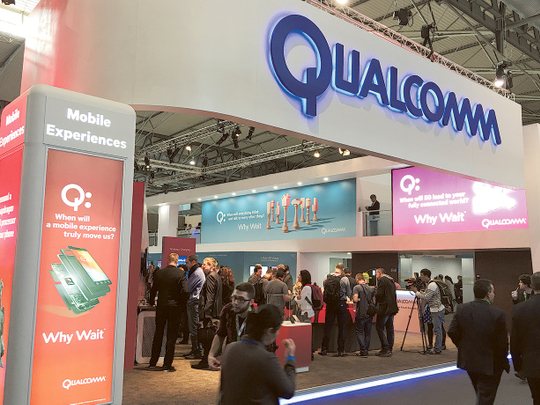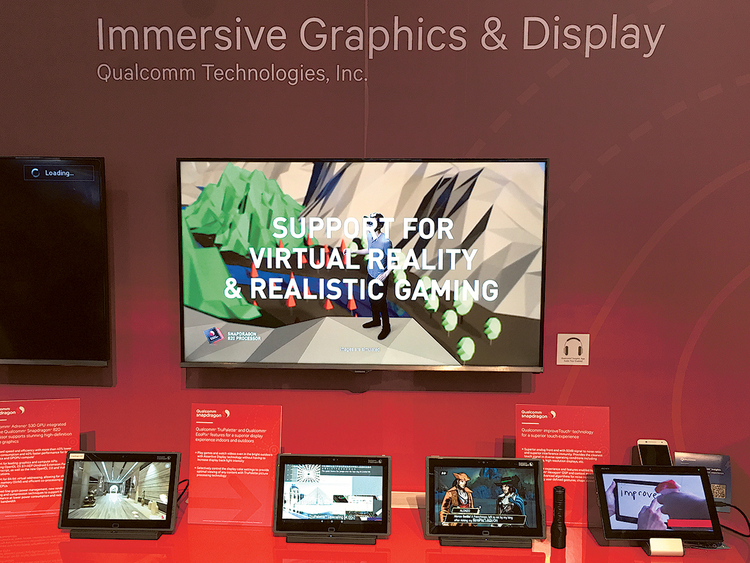
Dubai: After a rough 2015, Qualcomm started the year on a positive note with its new Snapdragon 820 processor by bagging some top smartphone manufacturers and also unveiling some new chips for automotive sector and Android smartwatches.
The American chipmaker had to endure a tough time in 2015 due to heat and power issues with its Snapdragon 810 processor, especially with its biggest client — Samsung for its S6 models.
But at the recent Barcelona Mobile World Congress, every leading smartphone manufacturer had a Snapdragon-powered device to show off to the world.
The new devices from Samsung — S7 and S7 edge — along with LG’s G5, Sony’s Xperia X Performance, HP’s Elite X3, LeEco’s Le Max Pro and Xiaomi’s Mi5 will run on the new chip. But S7 models with Snapdragon chips will be sold only in US, Japan and China while the rest of the regions will have its home-grown Exynos processor.
It is a big step forward for the chip giant as Samsung and Huawei’s home-grown processors, Apple’s A series and MediaTek, the company that’s been stealing away market share from Qualcomm for mid-tier and low-end devices, will figure as important counterbalances to this year’s upcoming Snapdragon ubiquity.
According to ABI research, Qualcomm remained a leader in the 4G LTE segment for 2015 with 65 per cent market share while the 4G LTE market is expected to grow at an annual rate of 78.6 per cent till 2019.
Moreover, the company faced difficulties in collecting licensing revenues from China, the world’s largest consumer of mobile phones, last year.
The Chinese handset manufacturers did not pay royalty payments on Qualcomm’s wireless technology patents.
But that is also settled as China’s more than 80 companies, including five largest smartphone makers — Xiaomi, Huawei, TCL, ZTE and Lenovo — have agreed to a major patent licensing agreement for 3G/4G technologies.
Qualcomm earns revenues by selling mobile phone chips and by licensing the technology to handset makers. It hopes to earn $10 billion by 2020 for the licensing side of the business, up from an expected revenue range of $7.3 billion to $8 billion this fiscal year.
To add to Qualcomm’s problems, the high-end smartphone segment is also slowing down.
According to research firm International Data Corporation, the smartphone growth is expected to drop to single digits in 2016, led by China’s transition from developing to mature market.
Latest projections show 2016 shipments of 1.5 billion, or 5.7 per cent growth over 2015. The trend of single-digit year-over-year growth is expected throughout the forecast with volumes growing to 1.92 billion in 2020. The market will continue to see volumes shifting to the low end with the aggregate market average selling price (ASP) dropping from $295 in 2015 to $237 in 2020.
The big question is how fast the company can transition its chips into a whole new breed of devices, including drones, virtual reality headsets, cars and servers as the smartphone industry is in a saturation phase.
Saturation in the smartphone market does not mean limited sales opportunities for Qualcomm.
The company is diversifying into new growth areas to and targets automotive, wearable, drone and virtual reality markets to drive growth beyond smartphones market.
Jay Srage, president of Qualcomm Middle East, Africa, South East Asia and Pacific region, told Gulf News that the company develops all of its technologies “with scalability in mind.” The idea is to get to market faster with the technologies that meet rising consumer demands.
He said the company is going through some “positive transitions” to gear up for the next wave of growth.
There are “multiple areas” where growth is going to come from.
Srage said that Qualcomm’s strategy is to expand beyond smartphones and into the internet of everything and consumer electronics.
“We are adapting to an accelerated and diversifying mobile environment, Re-aligning our resources, strengthening regional presence, accelerating 5G R&D, enabling new verticals.
He said that Qualcomm has shipped more than 900 million smartphones in 2015 and more than 8 billion chipsets worldwide.
“In emerging countries, we believe that mobile will be the single biggest driver of innovation and growth in the years ahead. For many people, their mobile phone will be their first experience with the internet. Data and content from the internet will play a critical role in improving people’s lives. Our focus is to bridge the digital divide by connecting people to the internet from their mobile phones,” Srage said.
In 2016, he said that 52 per cent of smartphones will be from China. The fastest acceleration of any mobile technology was triggered by China. The volume of smartphones coming out with 4G is much higher and at a cheaper price.
“We continue to lead across all segments from the low- to high-end phones. In the next three years, growth is going to come from automotive sector,” he said.
At the Las Vegas Consumer Electronics Show, Qualcomm announced a partnership with Audi for infotainment connectivity across their product lines.
The A5 and Q5 models will be shipping in with Snapdragon 602A chips in 2017.
The Snapdragon 820A for automobile sector features driver assistance with lane departure warnings, vehicle detection and traffic sign recognition, letting Qualcomm get into the heart of the connected car rather than just powering the infotainment system.
He said that next is the internet of Everything (IoE), a technology that connects trees, bulbs, plates, machines and people to the internet network, and data centres.
“The focus is going to be on wearables, connected audio and video, and in the very short time, we are going to expand into smart homes and appliances. We are going to be on the hardware side, build up the ecosystem platform to address the fragmentation,” he said.
Qualcomm has formed a joint venture with the Guizhou Province to accelerate its entry into the data centre market in China to sell server chips and take on Intel.
Intel’s x86 chip architecture currently dominates the PC and server chip markets. Server chips generate about $16 billion a quarter for Intel.
“The data centre is currently dominated by one or two companies in the past. Now, there is a need to establish a solution on the lower end of the business that will allow us to come at a certain entry point.
There is a significant business to get and this is a market that requires significant collaboration with third-party providers,” he said.
Qualcomm is going to shift its focus from mobile phones, which is at present 90 per cent, to 33 per cent by 2020. The growth is going to change and shift to other addressable sectors.
The new chips to be launched in the second half of the year- Snapdragon 625, 435 and 425 — are going to set the stage for mobile devices to become smarter in areas like gaming, cameras, video and connectivity.
By 2020, Qualcomm projects its total addressable market will more than triple to $100 billion by 2020 with $33 billion coming from mobile space and the rest to come other sectors like $18 billion from IoE and $3 billion from automotive sector.













